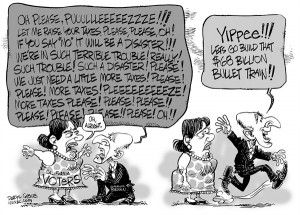California’s credit rating could get even worse
by CalWatchdog Staff | July 17, 2012 9:09 am
 [1]July 17, 2012
[1]July 17, 2012
By Joseph Perkins
California’s rock-bottom credit rating has been attributed in some quarters to the state’s most recent economic downturn, from which Gov. Jerry Brown said this past spring, “We are still recovering.”
But a new study by the Pew Center on the States suggests that California’s abysmal credit rating is neither a recent development, nor attributable to the recent recession. In fact, California has been the least creditworthy of the 50 states[2] over the past 11 years, according to Pew.
That included periods during which the state economy was mired in recession, from 2007 to 2009; and, before that 2000 to 2002 (following the dot-com bust). But it also included the state’s economic boom between 2003 and 2006 (fueled by the housing bubble).
And it included the administrations of three governors: Gov. Gray Davis, in office 1999 to 2003, who was recalled largely because of his fiscal irresponsibility. Gov. Arnold Schwarzenegger, 2003-2011, who was elected on promises that he would “terminate” the state’s fiscal problems, but only made them worse with excessive spending increases and tax hikes; and Brown, 2011-12, who is doing an Arnold imitation.
The business cycle affects all 50 states. But, explained Pew’s Steve Fehr, “The states with the lowest grades,” like California, “typically have trouble keeping their spending in line with their tax revenues.”
That’s why California’s credit is currently rated A- by Standard & Poor’s, the lowest among the states.
That means the Golden State’s debt is rated closer to triple-B, which amounts to junk-bond status –than it is close to triple-A, S&P’s highest rating, which, according to the credit rating agency, indicates an “extremely strong capacity to meet financial commitments.”
Back in February, state officials congratulated themselves after S&P upgraded its financial outlook for California from “stable” to “positive,” holding open the possibility that the state’s credit rating might rise from A- to A (which would still rank lowest among the states).
“The fact that California’s ratings outlook has shifted from negative to positive in less than a year in a powerful vote of confidence in our state,” said Brown in a statement.
S&P warning
As it turned out, the self-congratulations were premature. In March, S&P issued a report[3] noting the unwillingness of Brown and the Legislature to take the steps necessary to eliminate the state government’s structural deficit.
“In our view,” the report stated, “a waning appetite for more budget austerity among lawmakers could present a hurdle to timely and realistic budget solutions, which could interfere with the state’s credit quality to strengthen.”
S&P’s March report was followed by a report this past May. It found: not only might its upgrade of California’s financial outlook be short lived, the state’s credit rating could be downgraded as well.
“We could change the outlook to negative or lower the rating,” the credit-rating agency warned, “if we believe the state’s credit quality weakens through the budget process.
Last month, Brown and the Democratic-controlled Legislature enacted a budget for fiscal year 2012-13, which began on July 1, that does not have the spending cuts S&P was looking for, based on its March report, and that will not be “balanced” unless California voters approve Proposition 30, the governor’s $8.5 billion tax hike.
It’s doubtful S&P will look favorably upon this year’s budgetary legerdemain in Sacramento. The question is whether the credit rating agency will downgrade California debt even lower than it already is.
- [Image]: http://www.calwatchdog.com/2012/07/17/californias-credit-rating-could-get-even-worse/brown-tax-bullet-train-cable-cartoon/
- least creditworthy of the 50 states: http://www.pewstates.org/projects/stateline/headlines/infographic-sp-state-credit-ratings-20012012-85899404785
- S&P issued a report: http://latimesblogs.latimes.com/files/ca-03-30-2012.pdf
Source URL: https://calwatchdog.com/2012/07/17/californias-credit-rating-could-get-even-worse/